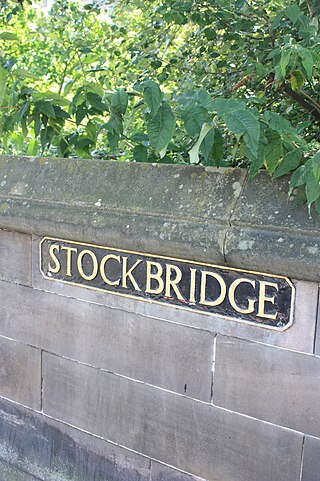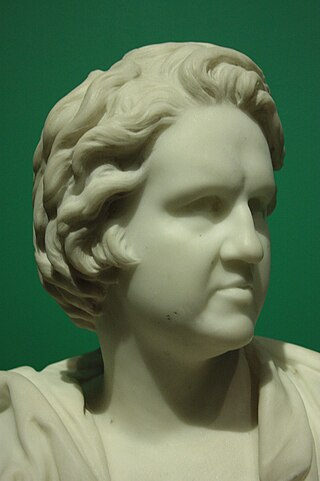
Nelson's Column is a monument in Trafalgar Square in the City of Westminster, Central London, built to commemorate Vice-Admiral Horatio Nelson's decisive victory at the Battle of Trafalgar over the combined French and Spanish navies, during which he lost his life, killed by a French sniper. The monument was constructed between 1840 and 1843 to a design by William Railton at a cost of £47,000. It is a column of the Corinthian order built from Dartmoor granite. The statue of Nelson was carved from Craigleith sandstone by sculptor Edward Hodges Baily. The four bronze lions around its base, designed by Sir Edwin Landseer, were added in 1867.

George Square is the principal civic square in the city of Glasgow, Scotland. It is one of six squares in the city centre, the others being Cathedral Square, St Andrew's Square, St Enoch Square, Royal Exchange Square, and Blythswood Square on Blythswood Hill.

The Monument to the Great Fire of London, more commonly known simply as the Monument, is a fluted Doric column in London, England, situated near the northern end of London Bridge. Commemorating the Great Fire of London, it stands at the junction of Monument Street and Fish Street Hill, 202 feet (62 m) in height and 202 feet west of the spot in Pudding Lane where the Great Fire started on 2 September 1666. Constructed between 1671 and 1677, it was built on the site of St Margaret, New Fish Street, the first church to be destroyed by the Great Fire. It is Grade I-listed and is a scheduled monument. Another monument, the Golden Boy of Pye Corner, marks the point near Smithfield where the fire was stopped.

David BryceFRSE FRIBA RSA was a Scottish architect.

James Pittendrigh MacGillivray was a Scottish sculptor. He was also a keen artist, musician and poet. He was born in Inverurie, Aberdeenshire, the son of a sculptor, and studied under William Brodie and John Mossman. His works include public statues of Robert Burns in Irvine, Lord Byron in Aberdeen, the 3rd Marquess of Bute in Cardiff, John Knox in Edinburgh's St Giles Cathedral, and William Ewart Gladstone in Coates Crescent Gardens, Edinburgh.

Stockbridge is a district of Edinburgh, located north of the city centre, bounded by the New Town and by Comely Bank. The name is Scots stock brig from Anglic stocc brycg, meaning a timber bridge. Originally a small outlying village, it was incorporated into the City of Edinburgh in the 19th century. The current "Stock Bridge", built in 1801, is a stone structure spanning the Water of Leith. The painter Henry Raeburn (1756–1823) owned two adjoining estates, Deanhaugh and St Bernard's, which he developed with the assistance of the architect James Milne. Milne was also responsible for the fine St Bernard's Church (1823) in Saxe Coburg Street. Ann Street, designed by Raeburn and named after his wife, is a rare early example of a New Town street with private front gardens.

The Column of Constantine is a monumental column built for Roman emperor Constantine the Great to commemorate the dedication of Constantinople on 11 May 330 AD. Built c. 328 AD, it is the oldest Constantinian monument to survive in Istanbul and stood in the centre of the Forum of Constantine. It occupies the second-highest hill of the seven hills of Constantine's Nova Roma, the erstwhile Byzantium, and was midway along the Mese odos, the ancient city's main thoroughfare.

Horatio Nelson, 1st Viscount Nelson (1758–1805) was a British flag officer in the Royal Navy famous for his participation in the Napoleonic Wars, most notably in the Battle of Trafalgar, during which he was killed. He was responsible for several famous victories that helped to secure British control of the seas, both securing Britain from French invasion and frustrating Napoleon's imperial ambitions. After his death during his defeat of the combined French and Spanish fleets at Trafalgar, there was a public outpouring of grief. Nelson was accorded a state funeral and was buried in St Paul's Cathedral.

Sir Geoffrey Boleyn was an English merchant and politician who served as Lord Mayor of London from 1457 to 1458. He purchased the manor of Blickling, near Aylsham, in Norfolk from Sir John Fastolf in 1452, and Hever Castle in Kent in 1462. He was the great-grandfather of Queen Anne Boleyn, the mother of Queen Elizabeth I. Sir Geoffrey built the domestic, mercantile and civic fortunes of the Boleyn family, and raised its status from the provincial gentry, as his brother Thomas Boleyn made a career of distinction in church and university, together building the family's wealth, influence and reputation.

Waverley Market is a shopping centre in Edinburgh, Scotland.

Nelson's Column is a monument, designed by Scottish architect Robert Mitchell and erected in 1809 in Place Jacques-Cartier, Montreal, Quebec, Canada, which is dedicated to the memory of Admiral Horatio Nelson, following his death at the Battle of Trafalgar. Subsequent to the destruction of Nelson's Pillar in Dublin (1808–1966), Montreal's pillar now stands as the second-oldest "Nelson's Column" in the world, after the Nelson Monument in Glasgow. It is also the city's oldest monument and is the oldest war monument in Canada.

Edinburgh City Chambers in Edinburgh, Scotland, is the meeting place of the City of Edinburgh Council and its predecessors, Edinburgh Corporation and Edinburgh District Council. It is a Category A listed building.

Sir James Gowans was an Edinburgh architect and builder.

The International Exhibition of Industry, Science and Art was a World's fair held in Edinburgh, Scotland in 1886.

John Stevenson Rhind was a Scottish sculptor based in Edinburgh.

Thomas Stuart Burnett ARSA was a Scottish sculptor in the 19th century.

Tailor's Hall, is a historic building in the Cowgate area of Edinburgh's Old Town. It was built in 1621 by the Guild of Tailors. It is now in use as a Stay Central Hotel.

The Melville Monument is a large column in St Andrew Square, Edinburgh constructed between 1821 and 1827 as a memorial to Scottish statesman Henry Dundas, 1st Viscount Melville.

The Nathanael Greene Monument is a public monument in Savannah, Georgia, United States. Located in Johnson Square, the monument was designed by William Strickland and honors Nathanael Greene, a general in the Continental Army during the American Revolutionary War. While the cornerstone was laid in 1825, the monument was not completed until 1830, at which time it served as a joint monument for Greene and fellow Continental Army general Casimir Pulaski. The monument became solely dedicated to Greene in 1853, after which two bronze plaques honoring Greene were added to the structure. In 1902, Greene's body was reinterred under the monument. In 2018, one of the bronze plaques was vandalized with googly eyes, which drew national attention to the monument.






















